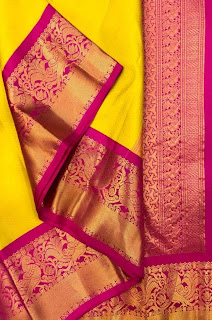TRADITIONAL SAREES FROM ODISHA : TYPE, DESIGN AND LOOK WITH IMAGES
The elegance
of traditional sarees from Orissa or now-a-days Odisha, the state of east India are worldwide
appreciated. Odisha saree has a rich heritage of textile with fine weaving work both on
cotton and silk. It is a treasure to every woman to have beautiful Odisha Saree collections.
The uniqueness of traditional Odisha saree is basically
due its diversity and variety which represents different districts of Odisha.
The 10 varieties of traditional Odisha handloom saree –
1. Sambalpuri Saree
from Sambalpur,Barhampur, Mayurbhanj Districts

2.
Bomkai/Sonepuri Saree
from Ganjam, Subarnapur District
Bomkai is another popular traditional handloom saree of Odisha received Geographical Indication of India tag with small ikat work in body and intricately
threaded or embroidered in border and pallu. Colours of the sarees are mostly
bright and found in both silk and cotton.

3. Khandua/ Katki Saree
from Cuttack District
Khandua or Katki is the most fashionable traditional saree of Odisha or called the pride of Odisha.
Traditional Khandua sarees are made up of silk, mostly found in red, orange and
yellow colour with elephant and lotus motifs in border and pallu.
4. Kotpad Saree
from koraput District
Kotpad handloom fabric is the item that received first Geographical Indication of India tag of
Odisha. The traditional sarees are organic or vegetable-dyed, woven by the tribal weavers.
The sarees are made up of both in cotton or silk with solid border and typical
motifs of tribal art.
5.
P
from Barhampur District
Pata sarees is most famous for its uniqueness in weaving design like
kumbha, temple etc with the zaree work in the border. This traditional silk sare is made in
joda (pairs)
–the saree for bride and the joda for groom to wear in wedding ceremony.
–the saree for bride and the joda for groom to wear in wedding ceremony.
6. Dongria Saree
from Rayagada and Kalahandi districts
Elegant traditonal Dongria saree is mostly made up of cotton, hand-woven by the tribal
group “Dongria Kandh” with rich embroidery work
with geometrical design in border and pallu.
7. Habaspuri Saree
from Kalahandi District
Traditional Habaspuri handloom saree is weaved by the kondh weavers of
Habaspur Village.These are mostly available in cotton fabric with traditional
pattern of design like kumbh(temple), flower, fish.
8. Pasapalli / Saktapar Saree
from Bargarh Distrct
This is a classy and delightful variety of Sambalpuri handloom. The name
derived from its print design like pasa of chessboard in entire body or pallu.
This traditional saree comes in both the variety of silk and cotton with excellence of
weaving art called “ Bandhakala”.
9.
Dolabedi Saree
from Gopalpur
Traditional exquisite looking Dalabedi saree comes in both cotton and silk. It
is a theme saree of Bedi means Mandap and Dola means Dol Utsava with
multicolour butas in the body and colourful border and pallu.
- 10. Soura Painting Saree and Patachitra saree
Saura printing saree are made by soura tribes of Odisha
which gives exclusive look for its unique traditional waril art print and usage of
geometrical frame.
Patachitra saree gives unique and fabulous look for traditional painting of Hindu mythology and life style of god and goddess on it with
natural organic colour.























Vary informational Blog! I loved it
ReplyDeleteSuper sarees collection.Those are perfect match for marriage.
ReplyDeleteGreat collection, thank you.
ReplyDeleteOdia Book Saptakhanda Haribansa
Order Odia Books
Odia Books Online
Great post. Thanks for sharing.
ReplyDeleteClick here to know more "Buy Handloom cotton saree in Bhubaneswar | Reemlydesignstudio"
Kudos to your efforts for this blog and such a informative blog which is never and ever seen. . I am searching for toni and guy hyderabad can you please guide me. Am waiting for your reply.
ReplyDelete